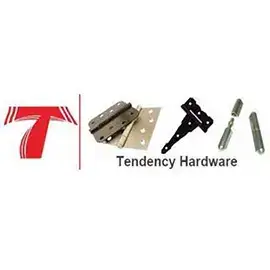Heavy duty hinges play a vital role in the construction industry, finding applications in residential, commercial, and industrial projects. However, it’s important to note that there’s no one-size-fits-all solution. Familiarizing yourself with the common types of heavy duty hinges used in construction is crucial. This article aims to provide insights into these hinges.
Why Heavy Duty Hinges Matter
Heavy duty hinges are not just simple components; they’re the unsung heroes that bear the weight of heavy doors, gates, and cabinets. Their significance lies in their ability to ensure the smooth operation, stability, and security of these substantial structures. Imagine a massive gate swinging open effortlessly or a sturdy cabinet door remaining aligned even after years of use – that’s the impact heavy duty hinges bring. These hinges are designed to shoulder the burden, whether it’s a commercial entrance, an industrial gate, or a robust cabinet. Without the right heavy duty hinges, these substantial structures might sag, misalign, or face premature wear and tear.
In essence, heavy duty hinges are the backbone of heavy applications, offering the strength and durability needed to keep things moving smoothly. So, when it comes to heavy doors, gates, or cabinets, never underestimate the pivotal role that heavy duty hinges play in ensuring functionality and longevity.
Comprehending Hinge Basics
Heavy duty hinges are specifically designed for applications that involve substantial weight and frequent usage. Their classification as “heavy duty” hinges stems from their robustness and leaf thickness. These hinges typically feature a leaf thickness of around 200 gauge, enabling them to bear weight loads ranging from 1,000 lbs. to 40,000 lbs. The hinge’s size also plays a pivotal role in determining its suitability for a given application, with sizes ranging from 5″ to 16″.
Factors to Consider When Buying Heavy-duty Hinges
1. Weight Capacity: This is the golden rule. Check the weight capacity of the hinge and make sure it can handle the load of your door or gate. Remember, it’s always better to go for a hinge with a slightly higher weight capacity to be on the safe side.
2. Material Matters: Heavy duty hinges come in various materials, such as steel, stainless steel, and brass. Consider the environment where the hinge will be placed. If it’s outdoors, opt for corrosion-resistant materials like stainless steel.
3. Hinge Type: There are different types of heavy duty hinges, including butt hinges, continuous hinges, and pivot hinges. Choose the type that suits your door or gate design and usage.
4. Size and Length: The size of the hinge matters. Measure your door or gate carefully and select a hinge that matches its dimensions. Also, check the length of the hinge to ensure it covers the entire width of the door or gate.
5. Security Considerations: If security is a concern, look for heavy duty hinges with features like security pins or concealed fasteners to deter tampering.
Varieties of Heavy Duty Hinges and Their Applications
Heavy duty hinges come in various types, each tailored to specific applications, ensuring that doors, gates, and cabinets can bear significant weight while maintaining stability and functionality. Understanding these hinge varieties and their ideal uses is essential for selecting the right one for your project. Here are some common heavy duty hinge types and their applications:
1. Butt Hinges
Description: Butt hinges consist of two plates connected by a pin. They are versatile and widely used in various applications.
Applications: Ideal for heavy doors, gates, cabinets, and industrial equipment. They provide smooth movement and can support substantial weight loads.
2. Continuous Hinges (Piano Hinges)
Description: Continuous hinges run the entire length of the door or gate, offering consistent support.
Applications: Often used for heavy-duty doors, especially those in commercial and industrial settings. They provide added strength and durability.
3. Pivot Hinges

Description: Pivot hinges allow doors to pivot on a single point, typically located at the bottom of the door.
Applications: Suitable for tall or heavy doors, particularly in settings where smooth movement and stability are crucial, such as entrance doors or industrial gates.
4. Weld-On Hinges

Description: Weld-on hinges are directly welded to the door, gate, or cabinet, offering a secure and robust attachment.
Applications: Commonly used in applications where frequent movement and heavy loads are expected. Examples include heavy machinery, industrial doors, and gates.
5. Security Hinges
Description: Security hinges are designed with features to prevent tampering or forced entry.
Applications: Used in applications where security is a top priority, such as secure storage cabinets, vault doors, and restricted access areas.
6. Spring Hinges
Description: Spring hinges have a built-in spring mechanism that assists in closing doors automatically.
Applications: Suitable for heavy doors that need to close automatically, such as fire doors and entrance doors in public spaces.
7. Ball-Bearing Hinges
Description: Ball-bearing hinges have ball bearings integrated into the knuckles to provide smoother operation.
Applications: Commonly used in heavy doors, gates, or cabinets that require regular opening and closing, such as warehouse doors and high-traffic entrance gates.
8. Gate Hinges
Description: Gate hinges are specifically designed for gates and offer various mounting options.
Applications: Used for metal and wooden gates, including driveway gates, garden gates, and industrial gates.
9. Load-Bearing Hinges
Description: Load-bearing hinges are designed to handle heavy loads and provide long-lasting durability.
Applications: Ideal for heavy machinery doors, equipment cabinets, and industrial applications where weight-bearing capacity is crucial.
Heavy Duty Hinges Installation
Proper installation is key to ensuring that your heavy duty hinges perform as they should. Follow these steps:
Prepare the Door or Gate: Make sure the area where the hinges will be installed is clean and free of debris. If needed, sand down any rough spots.
Mark the Hinge Placement: Use a pencil to mark the positions where the hinges will be attached. Double-check the measurements to ensure accuracy.
Drill Pilot Holes: Drill pilot holes for the screws. This prevents the wood from splitting when you insert the screws.
Attach the Hinges: Align the hinges with the pilot holes and attach them using the provided screws. Make sure the hinges are securely fastened.
Test the Movement: Open and close the door or gate to test the movement. It should swing smoothly without any resistance.
Heavy Duty Hinges Maintenance

To keep your heavy duty hinges in top shape, perform routine maintenance:
Lubrication: Apply a lubricant to the hinge pins to prevent rust and ensure smooth movement.
Tighten Screws: Regularly check and tighten the screws to keep the hinges secure.
Finial Thoughts
Choosing the right heavy duty hinges involves considering weight capacity, material, hinge type, size, and security features. Proper installation and routine maintenance will ensure that your doors, gates, or cabinets operate smoothly and securely. By following this comprehensive guide, you’ll be able to confidently select heavy duty hinges that meet the specific needs of your application, providing reliability and durability for years to come.























